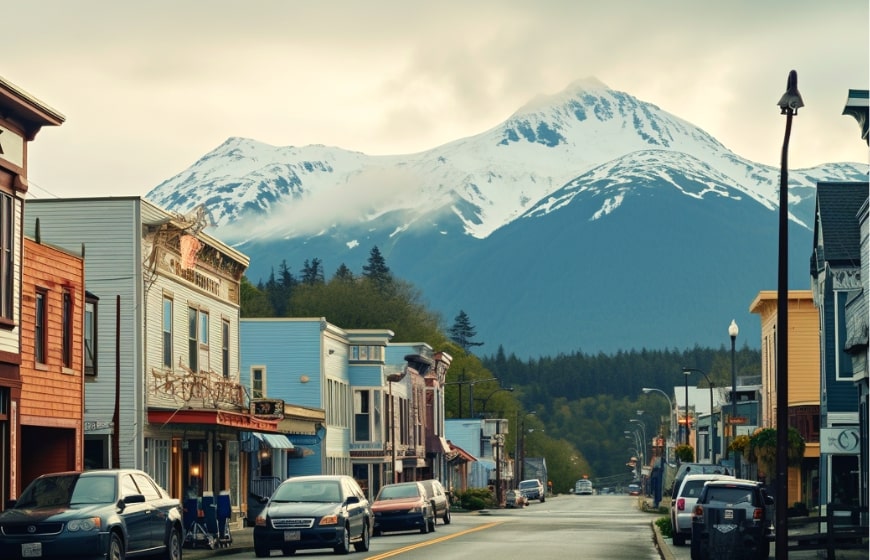
Mat Su Valley Lifestyle
Drive south on the Glenn Highway any weekday morning, and you’ll see a steady line of headlights heading toward Anchorage. That flow of people isn’t a sign of economic struggle. It’s a snapshot of how the Matanuska-Susitna Valley works.
Roughly a quarter of the Valley’s workforce makes that daily drive, living in Palmer or Wasilla but working in Anchorage. It’s not new. For decades, Valley families have built their lives around that balance: close enough to opportunity, far enough for peace.
Why So Many Choose to Commute
In Alaska, work happens where the jobs are. We’re talking about oil fields, military bases, schools, or boats. But home is where daylight, space, and family feel right.
That’s the balance the Valley offers. Lower housing costs, wider lots, and a slower pace of life make the 45-minute drive worthwhile. For many, it’s not even a daily trip. Rotational workers might spend two weeks on and two weeks off, coming home to a place that feels grounded and steady.
In that sense, the Valley isn’t just a bedroom community; it’s an anchor. It’s where people refuel between shifts, where kids grow up near grandparents, and where the sky always feels a little wider.
How the Commute Shapes the Market
This lifestyle makes the Valley real estate market unlike any other in Alaska.
- Housing Demand: Even when job markets shift, families want a consistent home base. The Valley’s affordability and connection to Anchorage keep that base strong.
- Home Features: Heated garages, large driveways, extra parking for work trucks or snow machines. Those features top the list for Valley buyers. Function often outranks fancy finishes.
- Rental Demand: Rotational workers and traveling professionals need homes near family or major routes. That steady stream supports a dependable rental market year-round.
Whether you’re buying, selling, or investing, the Valley’s “commuter pattern” creates a reliable, long-term demand base.
A Local Economy Built on Service and Support
While Anchorage supplies many of the jobs, the Valley supplies the life that makes them sustainable. Schools, healthcare, trades, and small businesses all thrive on that commuter energy.
Every new subdivision feeds local growth. Electricians, carpenters, and shop owners find steady work serving families who live here, even if they work elsewhere. That’s why Palmer and Wasilla’s local economies don’t depend entirely on outside employers. They’ve learned to grow from within.
Working in Anchorage, Living the Dream in the Valley
A few years ago, a couple moved from South Anchorage to Wasilla. She worked in healthcare in Anchorage; he worked rotation on the Slope. They wanted a little land, less noise, and a place to breathe between shifts.
Today, their kids attend school in the Valley, and both parents say the drive is “the best part of the day.” The morning commute, framed by Pioneer Peak, is their daily reminder of why they made the move.
Quality of life isn’t about distance to work; it’s about how that distance fits your rhythm.
Weathering Economic Shifts
Because so many Valley residents work in varied industries (oil, mining, healthcare, etc.), the region stays balanced even when one sector slows. When oil prices dip, construction and public services often keep moving. When tourism wanes, infrastructure projects and healthcare sustain jobs.
That diversity makes the Valley’s housing market more resilient than most. Even during statewide population dips, Palmer and Wasilla continue to add residents and new homes.
The Valley’s long-term market isn’t speculative. It’s built on steady, everyday life.
Looking Beyond the “Bedroom Community” Label
The phrase “bedroom community” doesn’t quite fit. It isn’t just where people sleep; it’s where they build, invest, and belong. The Valley supports Anchorage’s economy, yes, but it also fuels its own.
The people who make that daily or rotational commute are the same ones who volunteer at schools, coach hockey, and run small businesses. Their routines tie both regions together in a healthy, interdependent loop.
FAQs About the Mat-Su Valley Commuter Lifestyle
1. How long is the average commute from the Valley to Anchorage?
Most drivers spend 45–60 minutes each way, depending on the weather and the time of day. Many adjust their schedules or carpool to make the trip smoother.
2. Does commuting hurt home values in the Valley?
Not at all. Proximity to Anchorage remains a selling point. Valley homes often appreciate steadily thanks to lower starting prices and consistent demand.
3. Are there job opportunities within the Valley itself?
Yes. Healthcare, education, trades, and local government provide thousands of jobs. The Valley’s employment base has expanded steadily over the past decade.
4. How does the commute affect families?
Many families structure their days around it. Parents coordinate schedules, and flexible or remote work options have made it easier. The trade-off is more space and a quieter home life.
5. Is the Valley still affordable compared to Anchorage?
Yes. Median home prices remain lower, and larger lots are common. That affordability continues to draw new residents.
6. What kinds of homes are most popular with commuters?
Buyers often look for heated garages, strong internet, and easy access to highways. Functionality for trucks or trailers ranks high on the list.
7. How has the rental market held up?
Very well. Many short-term or rotational workers rent Valley properties, keeping vacancy rates low and stability high.
Let’s Talk About Your Next Chapter in the Valley
The Valley’s so-called “bedroom community” label misses the truth. These communities are more than where people rest between shifts; it’s where they plant roots and build lives.
Most folks don’t realize until they live here that you can work almost anywhere in Alaska and still choose to call the Valley home.
Are you thinking about making the Mat-Su Valley your home? The Valley Market Team can help you find the right fit. Reach out now to start your search.

